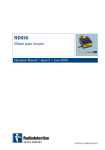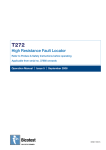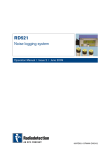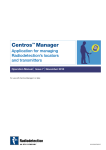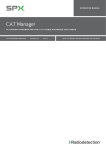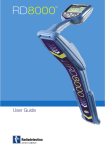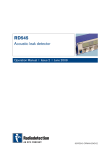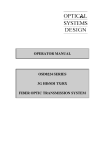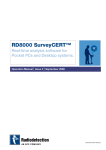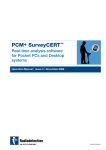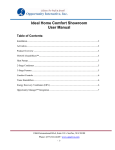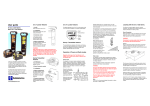Download User Guide - SPX Corporation
Transcript
RD560 Leak locator (tracer gas) Operation Manual l Issue 2 l June 2009 90/RD560-OPMAN-ENG/02 Preface Before you begin Thank you for your interest in Radiodetection’s RD560 leak locator. Please read this user manual before attempting to use the RD560 system. Radiodetection products, including this manual, are under continuous development. The information contained within is accurate at time of publication; however the RD560, this manual and all its contents are subject to change. Radiodetection Limited reserves the right to modify the product without notice and some product changes may have taken place after this user manual was published. Contact your local Radiodetection dealer or visit www.radiodetection.com for the latest information about the RD560 product family, including this manual. Important notices General This instrument, or family of instruments, will not be permanently damaged by reasonable electrostatic discharge and has been tested in accordance with IEC 801-2. However, in extreme cases temporary malfunction may occur. If this happens, switch off, wait and switch on again. If the instrument still malfunctions, disconnect the batteries for a few seconds. Safety This equipment should be used by fully qualified and trained personnel only. Reduce audio level before using headphones to avoid damaging your hearing. WARNING! This equipment is NOT approved for use in areas where hazardous gases may be present. ii RD560 Operation Manual RD560 Operation Manual iii Training Radiodetection provides training services for most Radiodetection products. Our qualified instructors will train equipment operators or other personnel at your preferred location or at Radiodetection headquarters. For more information go to www.radiodetection.com or contact your local Radiodetection representative. Copyright statement Table of contents Preface iii Before you begin iii Important notices iii General iii Safety iii Copyright 2009 Radiodetection Ltd - SPX Corporation. All rights reserved. Training iv Radiodetection is a subsidiary of SPX Corporation. Copyright statement iv Section 1 – General Information Section 2 – Operating the RD560 Section 3 – Measurement 1 3.1 Setting the acoustic indication threshold value 3 3.2 Zero point adjustment 3 3.3 Express cleaning of the sensor 4 3.4 Measurement with probe 4 Section 4 – Error messages 5 4.1 Excessive flow 5 4.2 Battery down 5 Section 5 – Charging the central unit 6 5.1 Memory effect 6 5.2 Power supply 6 Section 6 – Determining gas quantities Section 7 – Specifications 7 8 SPX and Radiodetection are trademarks of Radiodetection Ltd. and SPX Corporation. Due to a policy of continued development, we reserve the right to alter or amend any published specification without notice. This document is protected by copyright and may not be copied, reproduced, transmitted, modified or used, in whole or in part, without the prior written consent of Radiodetection Ltd. iv RD560 Operation Manual 2 3 RD560 Operation Manual Section 1 – General Information The RD560 was developed to detect even the smallest leaks on water supply pipelines. Hydrogen gas (H2) molecules are small enough to penetrate almost any substance and can be detected at the surface with a sensor. The device features two indicating ranges: 1. (LOW) 0PPM – 9.999 PPM 2. (HIGH) 1% – 9.99 % The device switches automatically from LOW to HIGH. The RD560 developed by Radiodetection combines sophisticated electronics with a powerful pump to produce short response times when tracking gas traces. The flow can be increased for a short time in order to air the gauge and the sensor. The measured data is displayed on the console and is also indicated acoustically as soon as the set value has been exceeded. The device is easy to operate via 5 keys. Each key uses an internationally understood symbol. The sensing electronics are housed in a rugged, well-designed, aluminium case which allows the use of the device under a wide range of conditions. Due to the modular design of the device, almost every part or component of the device is easy to maintain. This keeps maintenance and repair costs at a low level. vi RD560 Operation Manual RD560 Operation Manual Section 2 – Operating the RD560 The tracker is switched on by pressing key (1) ON/OFF. In order to avoid incorrect or accidental operation, the on/off key has to be pressed for approximately 1 second until the device acoustically confirms the operation with a beep. When you switch on the device, the Radiodetection logo will appear briefly on the display. During warm-up, the operator will see a bar that graphically indicates the remaining time until the device is ready for operation. At this time the pump is in operation. Once the device is ready for operation, the appropriate measurement parameters are displayed. Section 3 – Measurement The RD560 must be switched on in an environment that is free of H2. The device will be ready for operation as soon as the boot sequence is complete. The measured value is displayed graphically and acoustically based on a given threshold value. When the set threshold value has been exceeded, a red LED is activated in addition. If required, the operator can turn on the display’s backlight by pressing key (5). The internal loudspeaker can be activated / deactivated by pressing key (4). 3.1 Setting the acoustic indication threshold value The gas concentration is both displayed optically and indicated acoustically. The threshold value for acoustic indication is adjustable according to the operator’s specific requirements and can be set in steps of 50 ppm. 1. Keep the loudspeaker key pressed for about 10 seconds. a. the loudspeaker symbol will appear on the display. b. the set threshold value is shown under the loudspeaker symbol. 1. Changing the threshold value. a. press the loudspeaker key (4); threshold value will decrease. b. press the O key (3); threshold value will increase. 1. The new threshold value will be accepted by the device as soon as the operator has pressed the illumination key (5). % – ppm Unit to measure the concentration of the gas (automatically switched). Internal loudspeaker ON / OFF (is activated/ deactivated by pressing key (4)). Manually set the zero point, for example 25 ppm (can be changed by pressing key (4)). H2 concentration in ppm or % Graphical indication of battery capacity level. RD560 Operation Manual 3.2 Zero point adjustment Sometimes rooms are not ventilated sufficiently, and the H2 molecules are evenly spread in the room. Therefore, the RD560 will indicate an even concentration in the whole area. Pressing the 0 key (3) resets the basic value to zero. This enables the operator to more easily detect differences in concentration and to more precisely calibrate the leakage. When the basic concentration declines, the zero point is shifted automatically. RD560 Operation Manual 3.3 Express cleaning of the sensor When high H2 concentrations have been measured, the gauge and the sensor need to be “cleaned” after the measurement. In order to air the gauge and the sensor, press key (2), and the air flow through the sensor will increase considerably for about 25 seconds. After this additional 25-second ventilation, the device will switch back to its regular mode and its normal flow rate. 3.4 Measurement with probe The probe features an inbuilt H2 sensor, which enables the operator to check fittings and joints easily. When the probe has been connected, warm-up for this external sensor will start. The central unit then shows through a green LED that the measurement is conducted with the external sensor. Section 4 – Error messages 4.1 Excessive air flow rate If dirt, mud, or dampness is sucked into the device and the pump increases its air flow, a flashing symbol on the display indicates this excessive flow. If the air flow continues, the device switches off automatically. 4.2 Low battery The current capacity level of the battery is shown on the display. If the battery is completely discharged, the display shows a symbol accordingly and the device switches off automatically. RD560 Operation Manual RD560 Operation Manual Section 5 – Charging the central unit Section 6 – Determining gas quantities The RD560 uses rechargeable NiMH batteries. Formula: These batteries do not contain any environmentally damaging heavy metals. G = gas quantity in relation to the check pressure (L). When the batteries are fully charged, the RD560’s operating time is approximately 8 hours under permanent operation conditions. Charging the batteries may take up to 7 hours. VL = volume in liters required for one meter of pipe length (L). 5.1 Memory effect As the RD560 is equipped with NiMH batteries, the memory effect is only minor. However, the batteries should not be charged before their capacity has fallen below 25% of their total capacity. The current capacity level is displayed on the RD560’s display. 5.2 Power supply The RD560 can be charged both through a battery charger and through a 12v vehicle cigarette lighter. Supply voltage has to be between 12 - 14 volt, and the charging current has to be 1.0 ampere. As soon as the external power supply has been connected to the tracker, the green control LED will light up. The current capacity level and the duration of the charging procedure are displayed graphically while the device is being charged. When the charging procedure has been completed, the display shows the below symbol. G = VL x L x D L = pipe length (m). D = check pressure (bar). Volume table for the calculation of the gas quantities for different pipe diameters: Pos Pipe diameter in mm VL* 1 40 1.26 2 50 1.96 3 60 2.83 4 80 5.02 5 100 7.85 6 125 12.27 7 150 17.66 8 200 31.40 9 250 49.06 10 300 70.65 * Volume in liters required for one meter of pipe length. Example: A DN 125 pipe with a length of 300m must be filled with gas and pressurized to approximately 5 bar. Volume per meter x length = 12.27 liters x 300 meters = 3.681 liters at a pressure of 1 bar. At a pressure of 5 bars, 3.681 liters x 5 bar = 18. 405 liters have to be pumped in. As one 50 liter canister contains 10.00 liters of gas at 1 bar, the operator will need two canisters for the job. Note that there may be a certain reserve quantity needed for the gas evading at the leakage spot. RD560 Operation Manual RD560 Operation Manual Section 7 – Specifications Electronics: Microprocessor with 64 K ROM, 2048 Byte RAM, and 2K EPROM, 8-channel 12 Bit AD converter, inbuilt NiMh batteries with charge control, LCD with graphical capabilities. Sensor: H2 sensor for PPM range Measurement range: 1 PPM – 9.99 volume percentage Indication range: 0 - 9.999 PPM1 – 9.99 volume percentage Batteries: Rechargeable NiMh batteries (7.2v; 4.0 Ah). Operation time with fully charged batteries at least 8 hours. The time required to charge entirely empty batteries is 7 hours. The inbuilt automatic charging control unit stops the charging procedure as soon as the batteries have been fully charged. This extends the lifetime of the batteries considerably. The required charging current is 800 mA (at 12 volt). Only original charging units are permitted. Pump: Diaphragm pump with a flow rate of about 1.5 liters per minute. Alarm functions: Errors are indicated on the display, and the alarms control is activated when the device is switched on. The alarm is triggered through any malfunction of the device, e.g. when the pump is taking in water. In such a case, the pump will automatically switch off and discontinue operation. Alarm threshold: This threshold can be set for every measurement range through the (measurement) keyboard. Zero point: The indicator for every measurement range can be set to zero through the “0“ key at any time. If the values acquired fall below the set zero point, the set zero point adjustment automatically shifts to a lower level. Connections: Bell-shape probe, borehole probe, trailing probe - handheld probe with inbuilt sensor - charging unit RD560 Operation Manual Case: Powder-coated aluminium case Dimensions: 212 x 80 x 130 mm (LxWxH) Weight: approx. 1.7 kg RD560 Operation Manual America Radiodetection 154 Portland Road, Bridgton, ME 04009, USA Tel: +1 (207) 647 9495 Toll Free: +1 (877) 247 3797 Fax: +1 (207) 647 9496 Email: [email protected] Web: www.radiodetection.com Pearpoint 72055 Corporate Way, Thousand Palms CA 92276, USA Tel: +1 800 688 8094 Tel: +1 760 343 7350 Fax: +1 760 343 7351 Email: [email protected] Web: www.radiodetection.com Radiodetection (Canada) 344 Edgeley Boulevard, Unit 34, Concord, Ontario L4K 4B7, Canada Tel: +1 (905) 660 9995 Toll Free: +1 (800) 665 7953 Fax: +1 (905) 660 9579 Email: [email protected] Web: www.radiodetection.com Europe Radiodetection Ltd (UK) Western Drive, Bristol BS14 0AF, UK Tel: +44 (0) 117 976 7776 Fax: +44 (0) 117 976 7775 Email: [email protected] Web: www.radiodetection.com Radiodetection (France) 13 Grande Rue, 76220, Neuf Marché, France Tel: +33 (0) 2 32 89 93 60 Fax: +33 (0) 2 35 90 95 58 Email: [email protected] Web: http://fr.radiodetection.com Radiodetection (Benelux) Industriestraat 11, 7041 GD ’s-Heerenberg, Netherlands Tel: +31 (0) 314 66 47 00 Fax: +31 (0) 314 66 41 30 Email: [email protected] Web: http://nl.radiodetection.com Radiodetection (Germany) Groendahlscher Weg 118, 46446 Emmerich am Rhein, Germany Tel: +49 (0) 28 51 92 37 20 Fax: +49 (0) 28 51 92 37 520 Email: [email protected] Web: http://de.radiodetection.com Asia-Pacific Radiodetection (Asia-Pacific) Room 708, CC Wu Building, 302-308 Hennessy Road, Wan Chai, Hong Kong SAR, China Tel: +852 2110 8160 Fax: +852 2110 9681 Email: [email protected] Web: www.radiodetection.com Radiodetection (China) Hongfu Mansion, Room 61622, Zheng Ge Zhuang, Bei Qi Jia Town, Chang Ping District Beijing 102209, China Tel: +86 (0) 10 8975 5540 Fax: +86 (0) 10 8975 5640 Email: [email protected] Web: http://cn.radiodetection.com Radiodetection (Australia) Unit 14, 5-7 Prosperity Parade, Warriewood NSW 2102, Australia Tel: +61 (0) 2 9979 8555 Fax: +61 (0) 2 9979 7733 Email: [email protected] Web: www.radiodetection.com www.radiodetection.com Radiodetection products are under continuous development and are subject to change, we reserve the right to alter or amend any published specification without notice. Copyright 2009 Radiodetection Ltd. - SPX Corporation. All rights reserved. Radiodetection Ltd. is a subsidiary of SPX Corporation.









